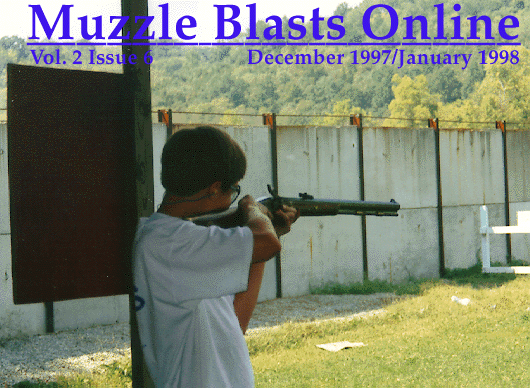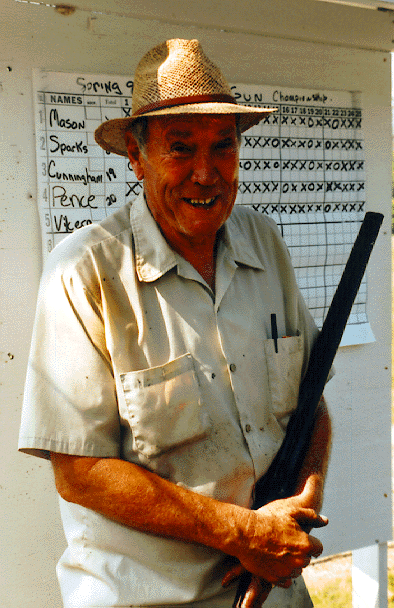|
Muzzle Blasts Online |
|
...for the muzzleloading enthusiast |
|
The muzzleblasts.com domain, subdomains, content, etc., are neither affiliated with the NMLRA nor its paper magazine Muzzle Blasts |
|
Muzzle Blasts Online |

|
|
|
|
|
|
Thoughts on Off-Hand
There are quite a few newcomers to the off-hand line whom I have never met. Some of them no doubt shoot better than I used to, and others, perhaps not. This article is submitted in the hope that it will help newcomers to improve their offhand shooting. This used to work for me when I could see clearly. I hope it helps some; it's worth a try regardless.

|
Please note: Your patching is going to be almost twice as thick as your depth of groove. Looking at one side of the ball while centered in the barrel, you have two-and-a-half thousandths before it touches a land. Let's assume that the groove is .008" deep. Now, beside the ball in each groove you have 10½ thousandths that we are going to stuff .017" thick patching into, which is good. This makes the seal and engages the barrel twist. If you place a ball in the middle of some bulk patch material large enough to afford a hand-hold and seat the ball just below the muzzle, you will see the weave of the cloth where the ball presses against the lands.
In a .32 caliber I had my best luck with 25 to 30 grains of 3F black. My .40 liked 40 grains, the .50 worked with 50 grains out to 50 yards, and 60 grains was fine at 100 yards for target work. Please note: you don't have to double the amount of powder just because the distance doubled.
Now, let's talk about hold and attitude. You shoot off-hand from the ground up. So kick out a little place for your feet, and return to these spots for every shot thereafter. I like my left foot a wee bit lower than my right. I can shoot on the level, but never with my left foot higher than my right. I sort of lean on my left hip and leg.
I want my left arm underneath the rifle and my forearm vertical holding the rifle. I don't hold the rifle any tighter than it takes to keep it from falling out of my hands--don't squeeze the sap out of the wood, or you'll just develop a tremor. If my left arm tires, I hold the rifle with my right and rest the buttplate on my belt. This is a good time to look at the grass in front of you, get a breathing rhythm, look at your target, pull yourself together, and stay within that 3-foot by 25- or 50-yard piece of ground you just paid a $1.50 for. All thought, all effort now flows through you as you raise the rifle for another attempt; it funnels out of you and off the top of the front sight right into the 10-ring. You should be able to get the shot off in the mental count of five; if you can't, take the gun down, and again go through the above procedure. You shoot the rifle; don't let the rifle shoot you! Control, command. The primary factor in off-hand is mental discipline.
You may find that you can push the rifle slowly to the mark you want to hit better than you can continue to hold on it. If this is the case, I would shoot on the rise and never on the fall. I used to come in on the black either at seven or five o'clock and kiss the trigger as the top of the front sight touched the 10-ring when using a percussion. Note: Don't try this with a flinter. With a flint, you must be able to hold through the count of five, kiss the trigger gently with your finger, and wait for the gun to fire. You shoot a flinter very gently, very kindly; wait for it.
Never, never, quit sighting to shoot. You sight, sight, sight, fire, sight, sight. If you are sighting after the shot, then you were sighting during the shot! Never be out of the nine-ring except at 100 yards and then take anything in the black. Targets are scored points, X's, then wide shots. The wide shot will loose in a tie, with score and X-count being equal.
Remember, you don't have to shoot the rifle every time you raise it to your shoulder; you can take it down, rest, think, and start over. Be in control! I recommend the center-hold sight picture because it helps in hunting, and in a turkey or primitive shoot, where the targets vary in size and shape. The distance from six o'clock to the center is not always the same. A ball that prints center on the 50 yard bull with a six o'clock hold will give you six o'clock nines on the 100-yard bull, and I would have no idea where to hold on the X-center target. The less distance you have to guess between your front sight and what you want to hit, the better. The longer the distance, the stronger the cross-wind, the tougher the guess.
Practice at home by holding your sights on a weighted string suspended from the ceiling through the count of five to develop your lateral control. Hold on a one-inch dot on the wall to develop vertical control. Use your double-set triggers while doing this; there's no need to cycle the lock and drop the hammer on a naked nipple or wear out a flint on a frizzen.
You may be the kind of person who can shoot better for someone else than for yourself. You may have a friend spotting for you; they are your support factor, and you don't want to let them down. It will please them, and you, when they say, "That's in there, give me another just like it."
Don't "rabbit-ear," don't listen to other conversations around you. You stay focused on your shooting-box, your loading, your walk to the line, your three-feet by 25-50-yard piece of ground, your target, your front sight, your ten-ring, and your control! Be able to call your shot: if it was a nine at three o'clock, say so. Know where the ball is going to print before you ever see the hole in the paper. If it's an X, say so, but quietly to yourself. Know the lag-time between when you caress the trigger and when the gun fires. I use the word caress to imply gentleness. Rough or jerky motions won't coax your rifle into shooting a ten.
There should be an affection between you and your rifle. If the gun does not perform, and the problem is not mechanical, then the trouble lies with you. Ball size, patch thickness, and powder charge must also be considered. Too much powder, just as too little, can affect your accuracy. Usually an increase of five grains for each 25 yards is enough.
Know your rifle, know yourself, combine the two in harmony, and apply the mental discipline. Call your shots; it's an excellent test, showing that you know how your shot delivery will appear on the target.